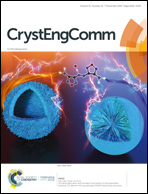Using polymorphism to master the spin crossover mechanism in [Fe(PM-PeA)2(NCSe)2]†
Abstract
In the crystalline state, a given molecule can have very different physical properties depending on the molecular packing within the sample. Despite this, the spin crossover is by essence a molecular scale phenomenon, and polymorphism leads to large diversity in the spin-switch features. The comparison of the structural and physical properties of the spin crossover polymorphs can therefore give crucial information about the phenomenon itself. As revealed in this study, the investigated molecular iron(II) complex has two polymorphic forms, one showing a first order spin crossover with a large hysteresis centered at room temperature and the other one showing a fully reversible gradual spin crossover at a lower temperature. The distinction between the two polymorphs is subtle and lies in the molecular stacking with regard to the interatomic contacts of the H⋯H, which underlines the extreme sensitivity of this physical phenomenon in the crystalline stacking. Interestingly, provided that the rational design of the polymorphs can be controlled, the crystallization of these polymorphs could open up perspectives as it allows dissimilar spin crossover mechanisms to be chosen when starting from the same molecule.
![Graphical abstract: Using polymorphism to master the spin crossover mechanism in [Fe(PM-PeA)2(NCSe)2]](/en/Image/Get?imageInfo.ImageType=GA&imageInfo.ImageIdentifier.ManuscriptID=C9CE01137D&imageInfo.ImageIdentifier.Year=2019)


 Please wait while we load your content...
Please wait while we load your content...